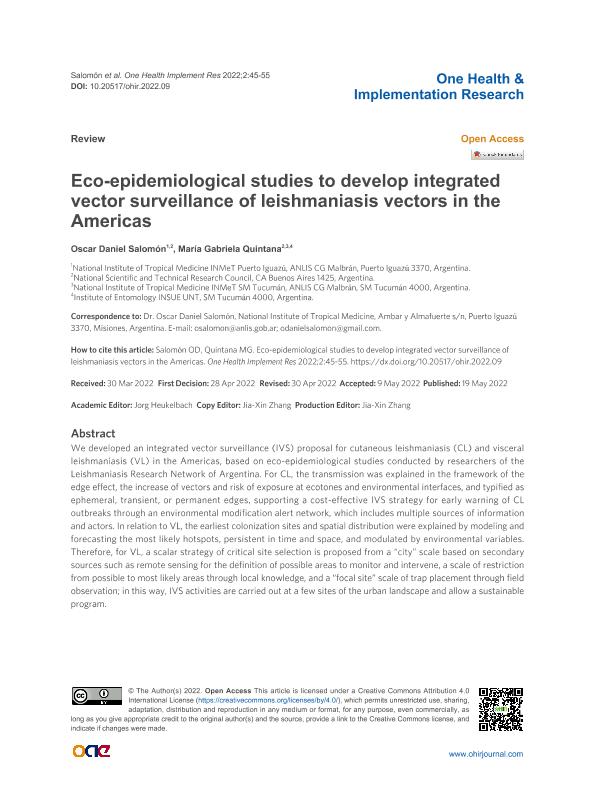Mostrar el registro sencillo del ítem
dc.contributor.author
Salomón, Oscar Daniel

dc.contributor.author
Quintana, María Gabriela

dc.date.available
2023-02-15T15:56:14Z
dc.date.issued
2022-05
dc.identifier.citation
Salomón, Oscar Daniel; Quintana, María Gabriela; Eco-epidemiological studies to develop integrated vector surveillance of leishmaniasis vectors in the Americas; OAE Publishing Inc.; One Health & Implementation Research; 2; 2; 5-2022; 45-55
dc.identifier.uri
http://hdl.handle.net/11336/188127
dc.description.abstract
We developed an integrated vector surveillance (IVS) proposal for cutaneous leishmaniasis (CL) and visceral leishmaniasis (VL) in the Americas, based on eco-epidemiological studies conducted by researchers of the Leishmaniasis Research Network of Argentina. For CL, the transmission was explained in the framework of the edge effect, the increase of vectors and risk of exposure at ecotones and environmental interfaces, and typified as ephemeral, transient, or permanent edges, supporting a cost-effective IVS strategy for early warning of CL outbreaks through an environmental modification alert network, which includes multiple sources of information and actors. In relation to VL, the earliest colonization sites and spatial distribution were explained by modeling and forecasting the most likely hotspots, persistent in time and space, and modulated by environmental variables. Therefore, for VL, a scalar strategy of critical site selection is proposed from a “city” scale based on secondary sources such as remote sensing for the definition of possible areas to monitor and intervene, a scale of restriction from possible to most likely areas through local knowledge, and a “focal site” scale of trap placement through field observation; in this way, IVS activities are carried out at a few sites of the urban landscape and allow a sustainable program.
dc.format
application/pdf
dc.language.iso
eng
dc.publisher
OAE Publishing Inc.
dc.rights
info:eu-repo/semantics/openAccess
dc.rights.uri
https://creativecommons.org/licenses/by/2.5/ar/
dc.subject
Visceral leishmaniasis (VL),
dc.subject
Cutaneous leishmaniasis (CL),
dc.subject
Eco-epidemiology
dc.subject.classification
Medicina Tropical

dc.subject.classification
Ciencias de la Salud

dc.subject.classification
CIENCIAS MÉDICAS Y DE LA SALUD

dc.title
Eco-epidemiological studies to develop integrated vector surveillance of leishmaniasis vectors in the Americas
dc.type
info:eu-repo/semantics/article
dc.type
info:ar-repo/semantics/artículo
dc.type
info:eu-repo/semantics/publishedVersion
dc.date.updated
2023-02-09T15:48:42Z
dc.identifier.eissn
2769-6413
dc.journal.volume
2
dc.journal.number
2
dc.journal.pagination
45-55
dc.journal.pais
Estados Unidos

dc.journal.ciudad
Los Angeles
dc.description.fil
Fil: Salomón, Oscar Daniel. Consejo Nacional de Investigaciones Científicas y Técnicas. Centro Científico Tecnológico Conicet - Nordeste; Argentina. Administración Nacional de Laboratorios e Institutos de Salud "Dr. Carlos G. Malbrán". Instituto Nacional de Medicina Tropical; Argentina
dc.description.fil
Fil: Quintana, María Gabriela. Consejo Nacional de Investigaciones Científicas y Técnicas. Centro Científico Tecnológico Conicet - Nordeste; Argentina. Universidad Nacional de Tucumán. Facultad de Ciencias Naturales e Instituto Miguel Lillo. Instituto Superior de Entomología; Argentina. Administración Nacional de Laboratorios e Institutos de Salud "Dr. Carlos G. Malbrán". Instituto Nacional de Medicina Tropical; Argentina
dc.journal.title
One Health & Implementation Research
dc.relation.alternativeid
info:eu-repo/semantics/altIdentifier/url/https://ohirjournal.com/article/view/4880
dc.relation.alternativeid
info:eu-repo/semantics/altIdentifier/doi/https://doi.org/10.20517/ohir.2022.09
Archivos asociados
